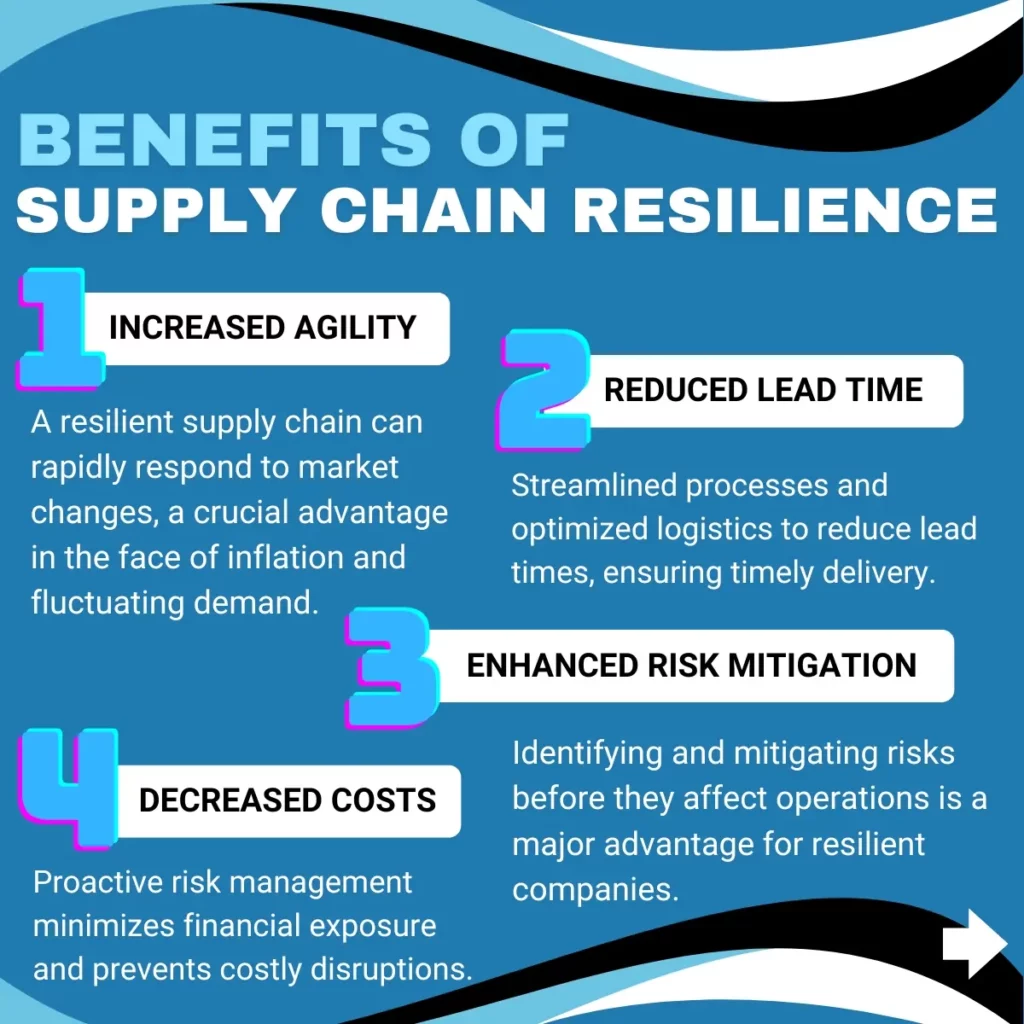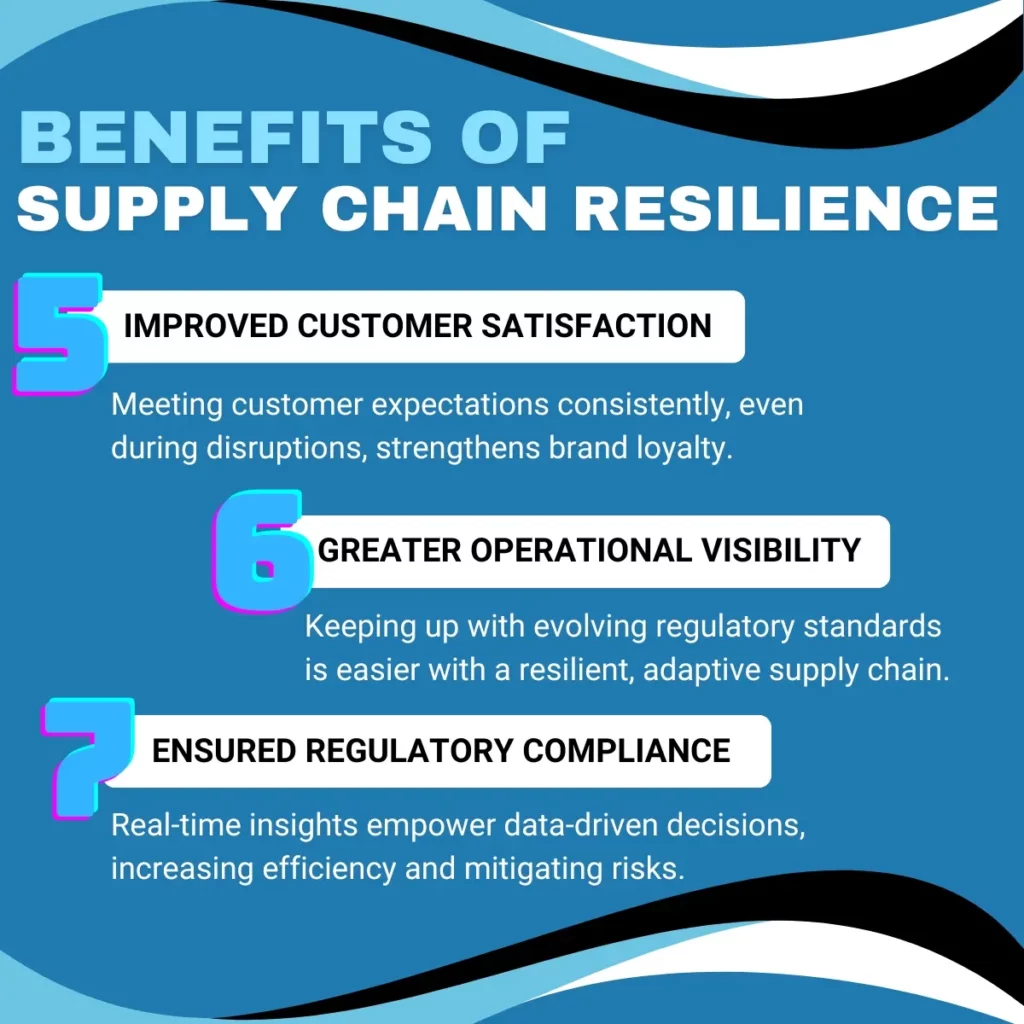In an era of escalating disruptions, supply chain resilience has emerged as a cornerstone of successful business operations. Supply chain resilience is a company’s ability to quickly adapt and recover from disruptions—whether they stem from geopolitical shifts, severe weather, or unforeseen natural events. Given the volatility in today’s markets, investing in resilient supply chain strategies is essential to prevent delays, avoid financial pitfalls, and ensure customer satisfaction.
Current Challenges in Supply Chains
The past two years have highlighted how interconnected the global supply chain truly is. Disruptions have arisen from diverse sources, such as the Russia-Ukraine conflict, which has led to energy price hikes and scarcity of raw materials, or the Suez Canal blockage in 2021, which underscored the vulnerability of critical transportation routes. Labor shortages, inflation, and tightening regulatory requirements add further challenges, creating unprecedented complexity for businesses worldwide. According to a 2023 survey, nearly 80% of companies experienced notable disruptions last year, primarily due to geopolitical issues and natural disasters, which directly impacted delivery times and raised costs.
Key Components of a Resilient Supply Chain
End-to-End Visibility
Real-time tracking across the entire supply chain enables businesses to identify potential risks early on. Technologies like AI-powered platforms and IoT devices provide continuous monitoring, offering transparency from raw material procurement to delivery.
For example, after experiencing delays from recent geopolitical issues, companies like Nestlé have implemented real-time monitoring to enhance visibility and responsiveness.
High-Quality Master Data
The foundation of resilient decision-making is accurate, high-quality data. Poor data can lead to misinformed decisions and costly disruptions. Master data management (MDM) systems are critical, providing accurate, consistent data that helps prevent overstocking, understocking, and inventory misallocations.
Companies like Unilever have invested heavily in data management systems to maintain accuracy in forecasting and supply chain decisions.
Effective Scenario Planning
Leveraging predictive analytics, companies can assess “what-if” scenarios to proactively prepare for potential disruptions. These tools allow companies to anticipate issues and create contingency plans.
For instance, after facing supply chain challenges due to extreme weather events, PepsiCo started using scenario planning to model the impact of climate-related disruptions and identify alternative routes or suppliers in advance.
Benefits of Supply Chain Resilience


Resilience initiatives deliver numerous benefits, including:
- Increased Agility: A resilient supply chain can rapidly respond to market changes, a crucial advantage in the face of inflation and fluctuating demand.
- Reduced Lead Time: Streamlined processes and optimized logistics to reduce lead times, ensuring timely delivery.
- Decreased Costs: Proactive risk management minimizes financial exposure and prevents costly disruptions.
- Enhanced Risk Mitigation: Identifying and mitigating risks before they affect operations is a major advantage for resilient companies.
- Improved Customer Satisfaction: Meeting customer expectations consistently, even during disruptions, strengthens brand loyalty.
- Ensured Regulatory Compliance: Maintaining evolving regulatory standards is easier with a resilient, adaptive supply chain.
- Greater Operational Visibility: Real-time insights empower data-driven decisions, increasing efficiency and mitigating risks.
Strategies for Building Supply Chain Resilience
Adopt Asset-Light Solutions
Outsourcing non-core functions like logistics or warehousing helps reduce strain on internal resources while improving flexibility. Companies like Walmart have adopted this approach, partnering with third-party logistics providers to manage peak periods without overextending their resources.
Prioritize Flexibility
Flexible warehousing and transportation allow companies to adjust operations as demand fluctuates. For example, Alibaba leverages a hybrid model, blending owned and third-party logistics solutions to scale quickly with demand surges and meet customer expectations seamlessly.
Create Diversity in Supply Networks
Relying on a single supplier or location exposes businesses to risk. Diversification of suppliers, and sourcing from multiple regions, enhances resilience. Apple, for instance, diversified its supplier network after experiencing geopolitical disruptions, sourcing from regions beyond Asia to reduce dependency on any single market.
Focus on Inventory Management
Effective inventory management balances costs and availability, ensuring that products are available when needed without overstocking. Ford improved its inventory strategy by maintaining safety stocks of critical components, which allowed them to respond quickly when chip shortages impacted the automotive industry.
Consider Nearshoring
Shifting production closer to key markets reduces lead times and transportation costs. Companies like Target have increasingly adopted nearshoring, relocating production to North America for faster turnaround times and reduced risks associated with long-haul transportation.
Build Inventory Buffer
Maintaining buffer stock of essential goods is a simple yet effective way to manage unexpected demand surges. Although this might increase holding costs, the cost of unfilled orders or production stoppages often outweighs the expense. Companies like Tesla keep a strategic inventory of crucial components to maintain production flow even amid supply fluctuations.
Case Studies Demonstrating Resilience Strategies
Below, you can find some companies that illustrate how resilience-focused strategies provide a distinct competitive edge. By leveraging advanced technology, diversifying suppliers, and implementing strategic planning, these organizations build supply chains that are both resilient and adaptable. Such approaches not only help them mitigate the impact of current disruptions but also position them to respond rapidly to future challenges, ensuring stability and continuity in a dynamic global landscape.
Walmart: Scaling with Asset – Light Automation and Expanded Fulfillment
Over the past year, Walmart has heavily invested in automation and data analytics to create an agile, asset-light supply chain. The retailer has introduced advanced automation across 55% of its fulfillment volume and plans to reach 65% automation in its stores by 2026.
This transformation aims to cut operating costs and boost efficiency, especially in handling high-demand periods like the holiday season. Walmart’s expanded same-day delivery network now reaches over 80% of the U.S. population, thanks to its enhanced fulfillment centers and AI-driven logistics planning.
Cisco: Leveraging Predictive Analytics and Digital Twin Technology
Cisco has implemented digital twin technology and predictive analytics to bolster its supply chain resilience. This technology enables Cisco to simulate potential disruptions, helping them adjust quickly to supply chain gaps, especially during critical periods such as the semiconductor shortage.
Their proactive approach minimizes downtime and keeps operations stable in uncertain conditions.
Procter & Gamble (P&G): Enhancing Supplier Diversity and FlexibilityMeasuring Supply Chain Resilience
In response to recent inflation and supply volatility, P&G has strengthened supplier relationships to maintain diversity in sourcing and flexibility in production. By actively collaborating with a range of suppliers, P&G has improved its ability to source alternative materials and distribute products through diverse channels when issues arise.
Their proactive inventory management and flexible warehousing strategies have allowed them to continue operating efficiently and meeting customer expectations amidst supply challenges.
Measuring Supply Chain Resilience
Businesses assess the effectiveness of their resilience efforts by monitoring specific key performance indicators (KPIs), such as:
- Order Fulfillment Rates: Measures the percentage of orders delivered accurately and on time.
- Inventory Turnover: Indicates how often inventory is used or sold within a given timeframe.
- Supplier Lead Times: Tracks how quickly suppliers can deliver orders once placed.
- Risk Exposure Levels: Monitors the number and type of risks identified and mitigated over a period.
Final Thoughts
In a world marked by political, environmental, and economic disruptions, supply chain resilience has become essential. Companies that invest in building resilient, flexible supply chains are better equipped to face challenges, minimize costs, and consistently satisfy their customers. Now more than ever, organizations must evaluate and fortify their supply chain strategies to prepare for an unpredictable future and seize opportunities for growth.
